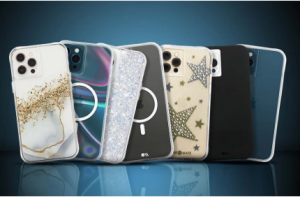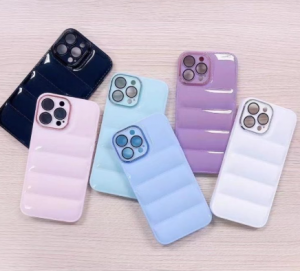In today’s digital world, smartphones have become an essential part of our daily lives. With the average cost of smartphones ranging from $500 to over $1,500, protecting them is a top priority. Phone cases come in various materials, each offering different levels of protection, durability, and aesthetics. But which phone case material truly offers the best protection? Let’s dive into the details.

-
The Importance of a Protective Phone Case
Statistics show that one in three smartphone users will experience a cracked screen within the first year of purchase. According to a study by SquareTrade, nearly 66% of smartphone users have damaged their phones at least once, with cracked screens and water damage being the most common issues. Given the high cost of screen replacements—ranging from $100 to $400, depending on the model—a durable phone case is a wise investment.
-
Types of Phone Case Materials and Their Protection Levels
(a) Silicone & TPU (Thermoplastic Polyurethane) Cases
Protection Level: Moderate
Silicone and TPU cases are among the most popular choices due to their flexibility and shock-absorbing properties.
- Pros:
- Shock absorption prevents minor drops and impacts.
- Lightweight and slim, offering a comfortable grip.
- Resistant to scratches and fingerprints.
- Cons:
- Not as durable as hard materials.
- Can stretch over time, leading to a loose fit.
💡 Fact: TPU cases can absorb up to 50% of the impact force from a drop, significantly reducing damage risk.
(b) Hard Plastic (Polycarbonate) Cases
Protection Level: Moderate to High
Polycarbonate cases are known for their strength and resistance to impact.
- Pros:
- Tough, impact-resistant outer shell.
- Lightweight and stylish with various designs.
- Offers moderate protection against drops.
- Cons:
- Can be slippery, increasing the chances of accidental drops.
- May crack under extreme pressure.
💡 Stat: A study from PhoneArena found that polycarbonate cases can reduce screen damage by 38% in drop tests.
(c) Rubber & Gel Cases
Protection Level: High
Rubber and gel-based cases offer excellent grip and impact absorption.
- Pros:
- Soft material absorbs shocks efficiently.
- Provides a secure grip, reducing the chance of slipping.
- Affordable and widely available.
- Cons:
- Can collect dust and lint easily.
- Bulkier than silicone or plastic cases.
💡 Fact: Studies show that rubberized cases can reduce fall impact damage by nearly 60% compared to unprotected devices.
(d) Leather Cases
Protection Level: Moderate
Leather phone cases are more about aesthetics than extreme protection.
- Pros:
- Offers a premium look and feel.
- Provides moderate scratch resistance.
- Ages well, developing a unique patina over time.
- Cons:
- Limited impact protection.
- Susceptible to water and stains.
💡 Stat: Leather cases can protect against scratches 25% more effectively than plastic cases but offer less shock absorption.
(e) Metal Cases (Aluminum & Titanium)
Protection Level: High
Metal cases are the most robust in terms of durability and protection.
- Pros:
- Highly durable and resistant to drops.
- Excellent protection against scratches.
- Provides a premium look and feel.
- Cons:
- Can be heavy and add bulk to the phone.
- May interfere with wireless charging and signal reception.
💡 Fact: A drop test conducted by TechRadar found that aluminum cases reduce impact force by 70%, making them one of the toughest options available.
(f) Hybrid Cases (Combination Materials)
Protection Level: Maximum
Hybrid cases combine different materials, such as TPU + Polycarbonate or Rubber + Hard Plastic, to offer superior protection.
- Pros:
- Multi-layered protection.
- Absorbs and distributes impact efficiently.
- Ideal for people who frequently drop their phones.
- Cons:
- Bulkier than single-material cases.
- More expensive than basic cases.
💡 Fact: Hybrid cases, like OtterBox Defender and Spigen Tough Armor, have been tested to withstand 10-foot drops without screen damage.
-
Which Material Offers the Best Protection?
While all these materials offer varying levels of protection, hybrid cases stand out as the best for overall safety. A combination of TPU and polycarbonate provides both shock absorption and a rigid shield, making hybrid cases the best choice for accident-prone users.
However, if you prefer a balance of aesthetics and protection:
- For everyday use, TPU and silicone cases are a great choice.
- For premium feel, leather cases add sophistication with moderate protection.
- For maximum durability, metal or hybrid cases are your best bet.
-
Additional Protective Features to Consider
Besides material, consider these additional protective features:
- Raised edges to protect the screen from face-down drops.
- Reinforced corners to absorb shocks effectively.
- Waterproof capabilities, especially if you work in wet environments.
-
Where to Buy Quality Phone Accessories?

If you’re looking for high-quality phone accessories, TrueGether is an excellent option. As one of the best eBay alternatives, TrueGether offers a diverse range of phone accessories with prices starting at just $1.53. Their product selection includes:
- Cell Phone Accessories
- Cell Phone & Smartphone Parts
- Cell Phones & Smartphones
- Smart Watches
- Smart Watch Accessories
- Phone Cards & SIM Cards
- Vintage Cell Phones
- Display Phones
With a variety of affordable and protective phone cases, TrueGether makes it easy to find the right protection for your device without breaking the bank.
Conclusion
With over 80% of smartphone damages caused by drops, investing in the right phone case is crucial. If you’re looking for the best overall protection, hybrid cases with TPU and polycarbonate layers provide superior durability. However, if you prioritize style and lightweight design, silicone, leather, or metal cases can be excellent choices based on your needs.
Ultimately, the best phone case material depends on your lifestyle and how much protection your device requires. Whether you opt for a slim silicone case or a rugged hybrid one, making an informed decision will ensure your phone stays safe for years to come!